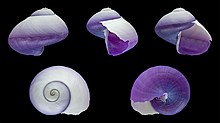Violet snail
| Violet snail | ||||||||||||
|---|---|---|---|---|---|---|---|---|---|---|---|---|

Violet snail, from Lesueur (1807): Voyage de découvertes aux terres Australes |
||||||||||||
| Systematics | ||||||||||||
|
||||||||||||
| Scientific name | ||||||||||||
| Janthina janthina | ||||||||||||
| ( Linnaeus , 1758) |
The violet snail ( Janthina janthina ), also known as the raft snail , is a snail from the genus of the violet snail ( Janthina ) in the family of the raft snail (Janthinidae). The lifelong pelagic , violet-colored snail floats on the surface of the oceans with the help of a raft made of slime. It feeds on cnidarians .
distribution
The violet snail occurs in temperate to tropical latitudes of all three oceans and in the Mediterranean .
Appearance
Like most snails, the violet snail has a right-handed shell . It is approximately conical, but can vary in shape and has a flat tip. The up to four whorls end in an almost triangular to rounded, wide case mouth. The body handling is great. The spindle is straight, often with a slight twist. The violet-blue colored, thin housing is almost smooth with clearly visible growth stripes. The bowl is up to 31 mm high, the mouth up to 22 mm wide. While the Veliger larva still has an operculum , this is no longer present in the adult animal.
The snail has a large head on a very agile neck. The very small eyes are at the base of the antennae.
The snail forms a chitin-containing raft of transparent, air-filled bubbles from its own mucus , on which it hangs with its belly side up and floats on the surface of the water. Therefore, the screw is reversed counter chat advantage .
Life cycle
The snail is first a male and later a female. Violet snails do not have a penis; rather, the sperm pass through the water from the male to the female. While other Janthina species attach up to two and a half million eggs to their raft, Janthina janthina is ovoviviparous , i. H. the eggs develop in the mother's fallopian tube until numerous bursting egg packets with fully developed Veliger larvae are shed from which they swim out. When the egg packets open in the fallopian tube, the larvae swim out of the genitals of the mother. One package contains around 20 or more larvae with a shell diameter of 100 to 230 µm. This is followed by a longer phase of the Veliger larva as zooplankton until the finished snail develops from it.
At the time of metamorphosis , the juvenile snail forms a long slimy stalk with a ball of air bubbles at the end, with the help of which the animal reaches the surface where the final raft will be formed. The air-containing mucous bubbles are formed with the foot, and a bubble takes about 10 seconds. If the snail loses its raft, it can only form a new one if it has contact with the surface of the water and thus with the air.
food
The violet snail feeds on cnidarians, especially sailing jellyfish and state jellyfish , including the highly poisonous Portuguese galley . Other pelagic snails and sea sandpipers are also attacked.
Individual evidence
- ↑ Gofas, S. (2009). Janthina janthina (Linnaeus, 1758). In: Bouchet, P .; Gofas, S .; Rosenberg, G. (2009). See also World Marine Mollusca database. World Register of Marine Species
- ^ Brockhaus' little conversation lexicon, 1911
literature
- Douglas P. Wilson and M. Alison Wilson (1956): A contribution to the biology of Ianthina janthina (L.) (PDF; 9.8 MB). Journal of the Marine Biological Association of the United Kingdom, vol. 35, pp. 291-305.
- Carol M. Lalli, Ronald W. Gilmer: Pelagic Snails. The Biology of Holoplanktonic Gastropod Mollusks . Stanford University Press, Stanford (California) 1989. Chapter 2, pp. 8-26: The Janthinid Snails: Raft Builders .
